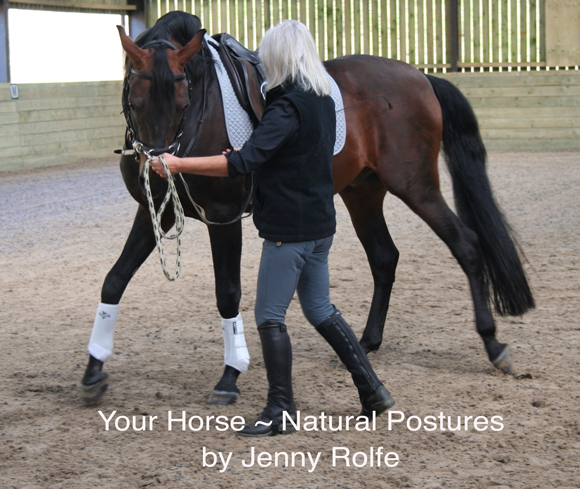Your Horse ~ Natural Postures
by Jenny Rolfe
COLLECTION OR RESTRICTION?
How would you define the word ‘collection’? I looked this up in the dictionary and found words like ‘gathering together’ and ‘pulling together’.
I then looked up the word ‘together’ and found such definitions as ‘in sync’, ‘in concert’ and ‘as one’. These last words formed in my mind, the picture of horse and rider performing Classical art, in true collection.
When we understand what it means to ‘collect’ the horse, we can study, in more depth, the way to achieve this goal in our training.
A horse in freedom will breathe naturally, attuned to the environment and situation around them. They will respond to the laws of nature as they are at one with their world. We try to control the horse by placing a bit in its mouth, a bridle around its head, and using reins, ropes, and more gadgets.
Unless the rider becomes attuned to the feel and sensitivity of the horse, their mount may feel discomfort and pain throughout the neck and head caused by the tightness and restrictions imposed by the bridle and reins.
Let us take a look at the reality of the punishment we inflict on the horse when we ask for a ‘fixed frame’ rather than a natural posture. Any athlete, whether human or equine, can only move freely when there is a lack of restriction to the head and neck, as these parts of the body need mobility to absorb any movement. Visualize the horse’s power and energy as it jumps into the canter strike off. The head and neck need to move forward to absorb this movement, but if the rider has heavy hands, the horse will only feel a restrictive tug in its mouth. In order for us to build the desire within the horse to step forwards with confidence, we need to build a relationship based on trust. This relationship is the true foundation necessary to ride with more trust and less gadgets!
The head and neck of the horse are not naturally located over its center of balance, and as the horse is in constant motion there will always be a need for the horse to compensate for any change in its balance. The head is positioned in front of the withers, the fulcrum of the neck. If the horse’s weight is unnaturally distributed with a constrained head and neck, the entire spine will tighten and therefore disturb the center of natural balance. The tightness within the spine will not allow the hind limbs to support the horse’s natural balance and carriage. The horse is also expected to carry the weight of the rider in this totally un-natural stance.
The true value of loose work is that when we can see the horse moving in graceful balance and posture with no tack at all, we can begin to realize that the connection we are looking for is both ‘mind to mind’ and ‘breath to breath’. This is our learning ground to connect with the language of the horse and maintain the same language once in the saddle. We communicate through our core breathing, energy, and balance.
Have you ever spent timeless moments looking over the gate of the field watching your horse when he is relaxed and grazing peacefully? Suddenly, he sees something on the horizon which startles him and he gallops off with his head and neck in the air, full of fear and flight. Then he comes to a halt, understanding that he is not being threatened, but his initial excitement remains. Just as quickly, your horse changes from fear to fun, and his strides reflects his pride and poise. His movement and balance are reminiscent of the Classical High School, executed with perfect grace and self-assurance. His neck is arched with pride as he displays both power and elevation. Fear has become fun and the horse is displaying his natural talent or true collection.
When a horse moves in collection, its haunches begin to lower as they absorb more of the body weight. The hind limbs increase in flexion which provide more propulsion and create significant energy. This flexion allows the horse more stability and increases its cadence. The spine and rib cage will elevate naturally, and enhance the mobility of the forehand and shoulders. When this process happens in a natural way, the neck of the horse extends up and away from the wither, demonstrating a ‘proud’ lengthened and arched neck.
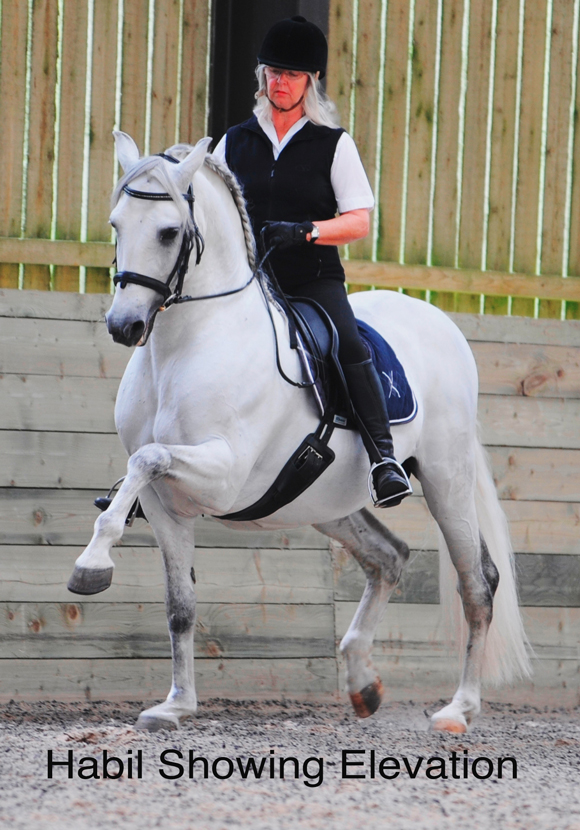
During our training, we are trying to emulate this pride, within the horse, to produce the gaits required for dressage.
The biggest challenge for the trainer is not only to work towards gaining high marks in competition, but to be working alongside a willing, athletic horse who is feeling both focused and confident.
LOOKING AT NATURAL POSTURE
When I am teaching, I am looking to enhance a natural ability for both the horse and the rider based on a connection through an awareness of breath-energy from the rider.
Correct posture for the horse will show a proud and confident horse, moving with good energy, through a mobilized spine, with the top muscles of the neck arched naturally, and with no pulling back. Correct training will ensure the horse looks more beautiful and athletic.
The head will align naturally through a relaxed poll, which may be a little in front of a vertical line or on the vertical. Depending on the energy of the movement, the carriage of the head and neck will vary. The correct posture will be longer and lower for a younger horse, as collection is built through years of correct training. The first ingredient is calmness, as a tense horse cannot sustain deeper rhythmic breathing and lung function, thereby affecting its circulation and freedom of movement. Tension also restricts the ability of the horse to concentrate on his responses to the rider.
We aim to build:
1. Flexibility in the muscle structure to support the skeletal system.
2. Balance and cadence through steady rhythm – always working towards equilibrium.
3. Alignment and straightness through methods of training.
4. A calm and focused horse who enjoys his work (natural movement for the horse is enjoyable, and as riders, we should seek to keep this feeling of joy in our training).
5. The result of a thoughtful training program is a horse whose beauty and pride is enhanced through its muscle structure. A focus on steady and rhythmic core breathing in order to enhance fluidity and eliminate tightness and restriction.
CREATING NATURAL SELF-CARRIAGE
Loose work is extremely beneficial as you can watch how the horse is moving and influence the horse with your body language and breathing. I like to begin by encouraging the horse to stretch forward and down. If the horse is not energized, this will not happen naturally, so you ask the horse to trot forwards with energy and then you will see him engage physically and mentally. The neck and head lower, relaxing and stretching as the horse becomes more calm and attentive to you.
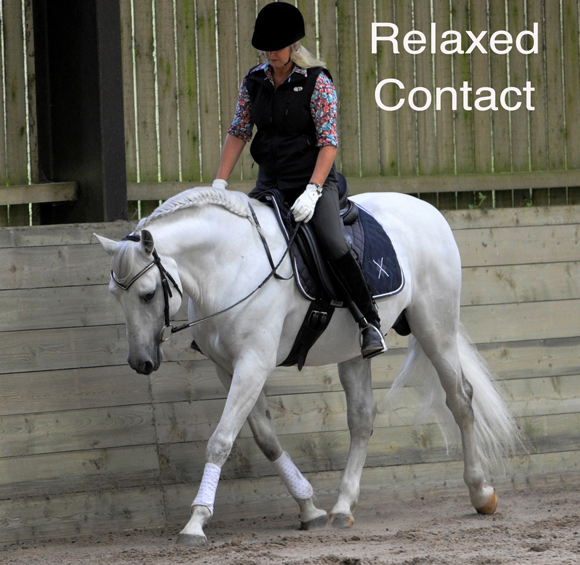
If the horse is lazy or inattentive, it will cause the head and neck carriage to become elevated, but as we ask for more energy within the gait, the horse will produce greater self-carriage and fluidity within its movement. This will result in a natural (not artificial) lowering of the head and neck carriage.
Loose work can encourage:
1 Natural balance with the energy needed to build the correct muscles of the top line.
2 Steady core breathing – to enhance fluid movement through a mobilized spine and relaxed rib cage.
8. Release of excess tension with a deep sigh.
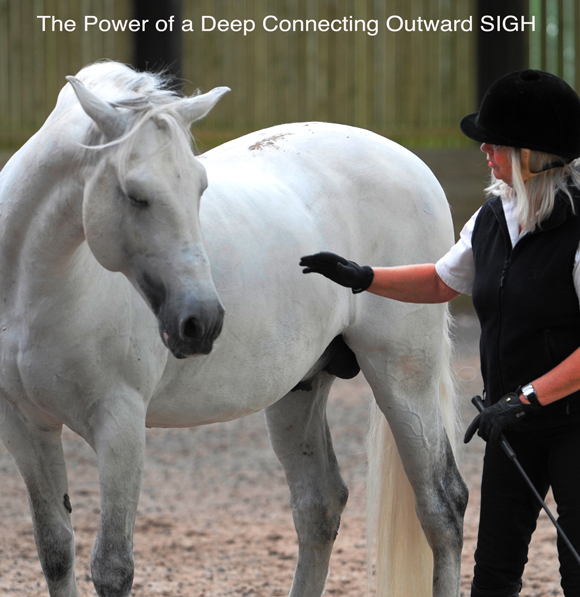
I use transitions and trotting poles in loose work to build up engagement. I may ask the horse to walk in a good march rhythm and to take two or three strides before the poles, (usually two or three poles which can be slightly raised), and then take a deep out breath to ask for trot. When the horse transitions from the walk and into the trot, the impulsion is taken from the hind limbs in the walk and the elevation over the poles helps to enhance vertical impulsion, cadence, and suspension.
Additionally, while doing loose work and lungeing, I ask for some strides in walk of leg yield on the circle. I ask the horse to look in from the circle, towards me, and then make a larger circle with the hind limbs, just for a few strides. This creates more engagement. I then ask for a forward trot on the circle with the hind limbs looking more engaged.
I vary the work from large to small circles and then onto a straight line.
These are exercises to develop both forward movement and more collection-the vertical impulsion which helps to gain cadence and self carriage.
WHY IS NATURAL POSTURE IMPORTANT?
Natural posture is fundamental to the well-being of the horse. When we try to force the horse into a frame, they become physically compressed, and cannot move freely through their spine and neck. Also, horses begin to disengage when they feel tension and tightness, and are unable to move without constraint.
When we focus on a more natural posture, we encourage a foundation which will help the horse to support the weight and balance of the rider. It takes time and patience to build a solid foundation, but this is the essence of helping the horse to become a healthy athlete. When the body is worked under duress- with tightness and restriction- injury often follows, and problems such as kissing spine will manifest themselves. The joints need space, and if the horse is not allowed to move naturally, the compression will cause friction and potentially cause an injury.
EXERCISES TO IMPROVE SELF-CARRIAGE, ENGAGEMENT, and SUPPLENESS.
One of my favorite exercises was taught to me whilst training in Portugal. It can be worked in hand- at liberty, with a cavesson only, or with side reins- and also under saddle. The exercise is executed in a steady walk – and with energy.
WORK IN HAND ON THE CIRCLE (left rein)
This exercise on the small circle will help to control the shoulders and also activate the engagement of the hind limbs. Prepare for this exercise by standing to face your horse, on the long side of the school. Begin with the exercise in walk and halt as described above. Then, instead of standing to face your horse, move slightly away from the track, to allow the horse sufficient space to be able to come away from the track and begin a circle around you. Prepare to circle left by positioning yourself both in front and slightly turned to face the horse. He will be on your left hand side, ready to move on a circle to the left. Hold the horse with your left hand and ask him to commence a circle to the left, around you. Holding the whip in your right hand, encourage the horse, with your voice, body language, and whip, to commence walking a circle around you. He should use his inside limbs laterally to cross in front of the outside limbs. The front legs should cross over as if performing a turn on the forehand. After a few strides, ask for a halt, and then repeat the exercise for just a few more strides. The horse must have sufficient space to mobilize his shoulders, to step forwards then across. If he is given too little room for movement, he may take a backward step, which is incorrect. The head of the horse should not become tilted, but instead remain in the vertical position. The flexion of the neck will be away from the direction of the movement, as in leg-yielding. When this exercise is carried out correctly, the horse will demonstrate greater elasticity of movement and his strides will promote more elevation and self-carriage. These movements should be carried out with steady precision.
The small circle exercise can be executed near the long side of the school. Whilst on the circle, as you reach the outside track again, the horse can be taken up the long-side in shoulder-in, again using the same principles.
This work is intense for the horse, so, initially, only use these exercises for a few minutes.
When riding this exercise under saddle, you can work the small circle and then continue walking forwards to ride a succession of exercises in a steady walk- to flow from a shoulder-in to the small circle. When we change the rein working from the left rein to the right, we can create equal cadence from both hind limbs, and suppleness through the shoulders and body of the horse. If a horse shows more stiffness on one rein, do not be tempted to over work that rein- instead, spend an equal few minutes on both. Halt regularly- to stand and take a deep sigh so the horse can release tension and take a break from concentration.
THE INFLUENCE OF THE RIDER ON THE NATURAL POSTURE
OF THE HORSE
The rider has a huge impact on the posture of the horse. For instance, if the rider is slumped, with an unsupported spine (and therefore weight) for the horse to support, the effect will be huge. When the rider learns how to carry and support their own weight, then the rider load feels much more balanced and lighter for the horse. This will give the horse more freedom to move and will affect the horse’s self-carriage.
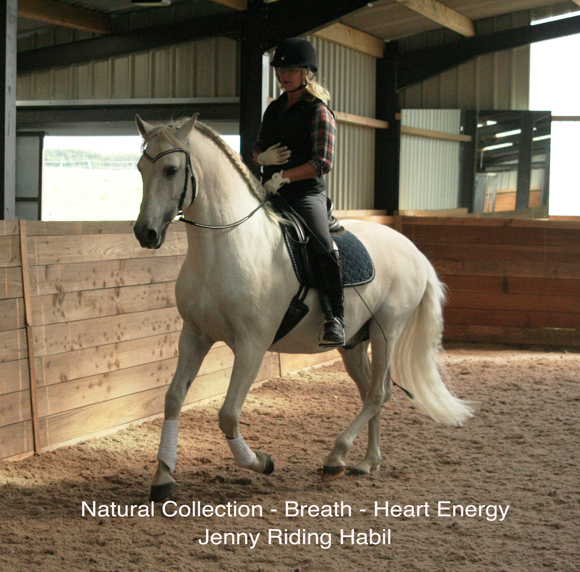
If the rider can learn to support their own self-carriage, then this will support the balance. The transformation for the rider will be a focus on core breathing, which will help to support their balance, stability, and mobility. Riding as an art is two living beings seeking harmony to move ‘together’ as one. Remember the balance is ever changing and I find that the focus on breathing can really help the rider to synchronize with the movement of the horse. For instance, if the horse tried to take a stronger hold with the bit, - then a deep inward breath in would will stabilize the rider and the horse would momentarily will respond by steadying and rebalancing. It is in this way that the rider can bring the horse back to a mutual balance. A deep breath out will support energy. Imagine you are jogging in a steady rhythm and supporting yourself with rhythmic core breathing. This type of breathing would help you sustain your mobility and flow of energy. It is the same when you are riding. Focus on steady core breathing- this supporting of the upper body, wide and full, will help the rider feel much lighter, and more connected to their horse. It is so subtle and very easy to teach the horse. The rider is sitting on the spine and central nervous system of the horse, so the horse will soon learn to respond to the rider’s breathing rather than strong leg aids, which stifle the natural movement of the horse’s rib cage. The horse will respond to energy flow through the spine and seat of the rider, and in this way, (‘breath to breath’, - ‘mind to mind’, and ‘heart to heart’) we can connect with our horse to experience both harmony and synchrony; it is after this connection is established, that the music can begin.
Jenny Rolfe is a Naturally Classical trainer and author living in the UK.
Students travel from around the world to work with Jenny and her Iberian stallions in order to learn the power of connecting with horses through the techniques of breath-energy. Information on her books, DVDs, and clinics are available at her website at www.naturallyclassical.com.



